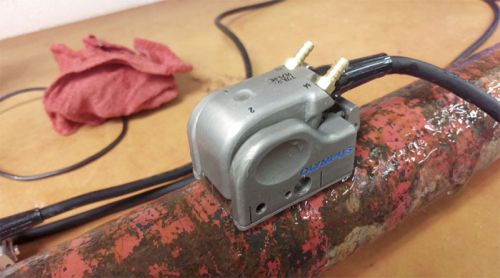Inspecting small-diameter pipes can be challenging. One common application where NDT technicians can have a difficult time is inspecting flow iron. Flow iron is a type of flowback pipe used in certain mining applications. Phased array technology is a preferred method of corrosion inspection in flow iron pipes because of its speed and accuracy. However, when the flow iron pipe has a small diameter, it’s difficult to detect corrosion on the inside diameter (ID).
A customer asked us to develop a solution for inspecting for corrosion in 2 in. and 2.39 in. outside diameter (OD) pipes. Our Dual Linear Array™ (DLA) probes are a good choice for this application because of their large beam coverage, fast scan speed, C-scan imaging with a high data-point density, and removable wedges.
 |
| DLA probe being used to inspect a piece of flow iron for corrosion. |
When using phased array probes to scan for corrosion on small-diameter pipes, coupling can become an issue—it can be difficult for the probe to maintain good contact with the pipe’s surface. Since the DLA probes have removable wedges, we were able to custom manufacture 2 in. and 2.3 in. OD wedges for the customer. Attaching these wedges to a DLA probe provided excellent coupling with no probe rocking.
The benefits of using DLA probes for inspecting small-diameter pipes include:
- Good coupling on pipes larger than 2 in. OD
- Increased range of corrosion inspection
- Reduced inspection time, increased coverage, and improved data analysis
- Integrated irrigation ports for continuous coupling
- The wedges help protect the probe from rough surfaces
- Wedges can be replaced, helping reduce costs
This example demonstrates that DLA probes with removable wedges are an effective solution for corrosion inspection on small-diameter pipes. Check out this video to learn more about what DLA probes can do.
Get In Touch
.jpg?rev=2D3E)
